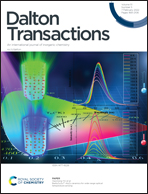Construction of bifunctional electrochemical biosensors for the sensitive detection of the SARS-CoV-2 N-gene based on porphyrin porous organic polymers†
Abstract
In this study, a novel porphyrin-based porous organic polymer (POP) was constructed using 5,10,15,20-tetramine (4-aminophenyl) porphyrin (TAPP) and 5,5′-diformyl-2,2′-bipyridine (DPDD) as organic ligands via a solvothermal method (represented as TAPP-DPDD-POP). Then, it was utilized as a bifunctional scaffold for constructing a sensitive sensing strategy toward the nucleocapsid phosphoprotein (N-gene) of SARS-CoV-2. The obtained TAPP-DPDD-POP is composed of nanospheres with a size of 100–300 nm and possesses a highly conjugated and π–π stacking network. The coexistence of the porphyrin and bipyridine moieties of TAPP-DPDD-POP afforded considerable electrochemical activity and a strong binding interaction toward the SARS-CoV-2 N-gene-targeted antibody and targeted the aptamer strands of the N-gene. The TAPP-DPDD-POP-based aptasensor and immunosensor were manufactured for the sensitive analysis of SARS-CoV-2 N-gene, and exhibited the limit of detection (LOD) of 0.59 fg mL−1 and 0.17 fg mL−1, respectively, within the range of 0.1 fg mL−1 to 1 ng mL−1 of N-gene. The sensing performances of both the TAPP-DPDD-POP-based aptasensor and immunosensor were better than those of existing electrochemical biosensors for analyzing the N-gene, accompanied with excellent stability, high selectivity and reproducibility. The TAPP-DPDD-POP-based aptasensor and immunosensor were then employed to detect the N-gene from various environments, including human serum, river water, and seafoods. This work provides a new method of using an electrochemically active POP to sensitively and selectively analyze SARS-CoV-2 in diverse environments.



 Please wait while we load your content...
Please wait while we load your content...